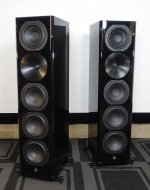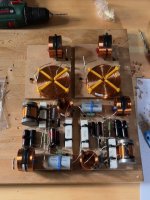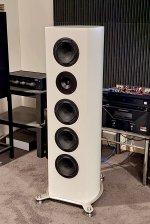this Arendal reminds me of Elsinore MKV, I think maybe it's time for Elsinore to reach into one of the BIG Reviewer if anyone knows and lives nearby
https://arendalsound.com/series/1723-series-speakers/
https://www.audioholics.com/tower-speaker-reviews/arendal-1723
https://arendalsound.com/series/1723-series-speakers/
https://www.audioholics.com/tower-speaker-reviews/arendal-1723
Attachments
A study is being done to show the effect of series inductors and distortion, with initial results in yesterday which show that cored inductors contribute to distortion. These numbers don't state anything about audibility. A powdered iron core can produce more distortion than a conventional iron core, which can produce more than an air cored inductor.I just compared current distortion
....
I also tried some inductors,1mH air coil, was a minor improvement, 1.5mH iron core was actually worse.
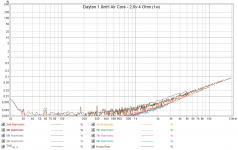
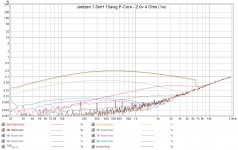
https://www.mtg-designs.com/tips-tricks-tests/inductor-testing/inductor-testing-part1
So lets just imagine someone gave up on building the MFC Els but is now losing sleep over the ULD Els. And imagine he sold all the bits and pieces except the crossovers. How many of those xover parts would transfer to the ULD xover? Asking for a friend.
Had a quick glance, the crossover looks quite different for the ULD version.
If I saw correctly you would be able to re-use R1, L3, C1, C2 and C3 from the MFC crossover.
Basically a change to another good dome tweeter will result in a modest change of "flavor"...
In January-February we should be able to get some answers as we shall see what an "NBAC" version with SB26ADC tweeter comes up like. This will be the first time that we shall be trying "hard" drivers (aluminium, ceramic etc) instead of "soft" drivers (paper, fibre, polyprop or polycones etc). The only reason that I am trying this with "hard" drivers is that the SB17NBAC is the first driver that I have found, that it might be possible. So I am intrigued and with Steve's financial help (sponsor) with the drivers and the fact that I have a pair of boxes that can be used.
I will be away from the Friday to Dec 25. I have two EL-6 boxes I want to get painted, but summer holidays may mean a little wait. So second half of January I am hoping. Then I can do the work on the boxes and fit drivers - then I can start doing testing and modeling of the drivers in situ, in the box. Driver measure differently depending on the box. I don't guess what the box will do, but measure them in such a way that the guesswork is taken out of the equation. All measurements are carefully calibrated. Once reliable data, both acoustic and electrical, the preprocessing takes place in Clio's software, combining near and farfield along with port output, on and off axis data, a very complete and revealing set. This is now loaded into SoundEasy and now the computer modeling can take place - and if we have done everything right and not blundered, this is where we can see what the crossover does, electrically, acoustically, on and off axis. The crossover will look similar I predict, but the all-important values will not be the same
I only mention the above because Steve has already used the drivers in a relative ad hoc way (no condescension meant) in his EL-6 boxes. But not this full development cycle which will be shared with him and a physicist friend. This process, as you can see, takes a fair highly scientific approach, one that will reveal many things and helps us how all the elements hang together or don't.
Whatever happens, happens!
Cheers, Joe
.
This will be very interesting. I hope the drivers work out. I have had good luck with aluminum drivers in the past.
It's the CSD "waterfall plot" that made me think that this "hard" version of the Elsinores might work. So we shall try the SB17NBAC35-8.
Borrowed the graphs below from Troels Gravesen, read his comments too because they mirror my thoughts.
"Frankly, I never thought I'd do a speaker from all aluminium (cone) drivers. My most recent experience dates back some 10 years and the midbass was harsh on my ears. Later the manufacturer modified the drivers (cone curvature) for better performance, but I never got around to doing them again.
When I first set up this SBA driver and turned on the MLS signal from the CLIO I thought I'd done something wrong - or was suffering temporary loss of high-frequency hearing . Well, I hadn't. Usually you can hear from the very MLS signal if a driver is trouble or if it's smooth on the ear. This SBA driver was smooth on the ear. Apparently the cone design with the ribbed imprints does its thing in reducing cone break-up."
The above is what convinced it was worth a try, thanks Troels. Yes, we are both users of the Clio system.
Look at the ridge around 10KHz that is common to all three.
The polypropylene is the "MFC" cone and I think I am reading Troels thinking a bit here, that the "MFC" lends itself better than the other two to a 1st order crossover. It actually seems that of the three the paper "NRX" on the right is the worse and the aluminium "NBAC" is in the middle.
When I visited Troels in Aarhus, he queried why I have gone for the "NRX" cone version. It wasn't later I got to thinking that he was telling me I should have gone for the MFC polycone/polypropylenes. In time we did go to them when the "NRX2" replaced the original "NRX" was too different, and that meant I have to make the change. So Troels, I believe we ended up with the one you had in mind, the MFC, in the end.
It is interesting in following Troels over the years, how he has slowly graduated towards low order and 1st order crossovers.
Yep, there is something about the sound, most think the reason for sounding better is on the acoustic side, but I am convinced that 1st order deliver more accurate force/acceleration to the driver because the series element in a 1st order crossover suppresses the non-linear inductive impedance of the driver.
This is also the key to why some like playing around with current-drive: The commonality is that there is less distorted current coming from the amplifier (and nobody is bothering to measure both current and voltage distortion simultaneously) and that means more accurate force/acceleration at the driver interface. So a 1st order crossover can improve the situation, but I strongly suggest that high-order crossovers mess up the current, particularly when you mix low frequencies (visible excursions) with mid-frequencies, most drivers (are not like Purifi drivers) modulate that force/acceleration factor and you are actually modulating the impedance of the driver:
EXCURSION IMPEDANCE VARIATION:
Red is when the cone is centered, Blue is when the cone goes in and Green is when the cone goes out.
Unstable impedance.
Unstable current from the amplifier.
The current of the amplifier is being modulated and the amplifier can do nothing to stop it.
Analyse this and you will realise that adding some series inductance with stabilise this for the better. It suppresses non-linear inductive effects of the driver, and the improvement is similar to that of going down the current-drive road.
Now ask yourself, how is the crossover performing now if this is a 4th order crossover 2-4KHz and the termination impedance of the crossover is fizzing about like that? That is not a pretty picture. The higher the order of the crossover and the margins become smaller, the situation less forgivable. Current is inversely proportional to the impedance, so this is an open and shut case. You are current modulating the crossover because the amplifier's current is being modulated. And this is usually happening at the very frequencies we are most sensitive.
BUT: The problem lessens when you have lower order, there is more error allowed and with a single 1st order series inductor you actually stabilise the problem. The driver has a problem, but the problem is less if you have a single inductor. And you can definitely hear it.
Say you measure 0.15mH around 2KHz, this is about right for the SB17 drivers which all have the same 'motor' assemblies, magnet, coils etc.
Now if you could even add 0.15mH inductor, you have a chance of suppressing those non-linear effect by 2:1 or 6dB. If you add 0.5mH you are up around 10dB. Now consider the SB17 driver inductance actually drop with frequency, to around 0.07mH, that means our stabilising inductor has an effect that improves with frequency up to 10KHz, and now we actually get higher than 6dB or 10dB improvements that we roughly calculated.
But it takes a leap of faith to go down that route, but find the right drivers and don't overcorrect their faults. Allow the driver to have some flaws. Don't throw the baby out with the bathwater. In correcting one thing we make actually make things worse elsewhere that might be more important.
Phase linear loudspeakers? Or whatever you want to call them. Yes, the use 1st order to get that effect. But are the barking up the correct tree?
WHY DO 1ST ORDER SOUND BETTER TO SO MANY?
ACOUSTIC OR ELECTRICAL?
Ah, many claim it is the better acoustic phase response. This is what many believe is the reason a good 1st order filter sounds better, the near perfect step response:
But that is an acoustic explanation and in terms of studying hearing, the official psychoacoustic theory says that it should not matter if it happens under 7 milliseconds, the human ear's integration period. If acoustic phase is the reason for the audible improvement, then we are yet to have found a scientific explanation.
My recommendation, don't try to find it because I believe it is not there, it is not on the acoustic side at all.
The answer is on the electrical side, not the acoustic side.
The improvement we hear is related to better current delivery and improved force/acceleration that is directly due to current alone.
Any series element will improve current delivery. Esa once admitted to me about ten years ago that adding resistors is an improvement. But it did not occur to him that an inductor is even better than a resistor, especially if we combine it with drivers with low inductance in the first case. He came up with resistor/resistance to load being 5:1 or better. I actually agreed with that. But the inductive ratio of 5:1 is actually better and gets you the same benefits as current-drive. And it is not rocket science.
On the electrical side there is a connection between first-order and what current-drive does - and the audible improvement is actually similar. It is strange that nobody has seen that coming.
I haven't anybody say that before.
So I will leave it here. This is dangerous stuff to talk about online, but that is my opinion and I am not forcing it down anybody throats. But I think I can make a good case. Others are welcome to make their own.
Cheers, Joe
Joe,
can you try Satori TW29RN this time since you are going to experiment anyway
It's not that simple. The waveguide also has to work and it looks like SB26ADC will work with just the addition of a O'ring and drill out and enlarge a few holes. Other than that, I do like the Satori TW29RN tweeter, but it would require a new waveguide design and can you spare me the not inconsequential dollars? I already have thousands of dollars work of the existing waveguides. It looks like we have two tweeters that work with it.
The idea of preventing the drivers from modulating the current of the amplifier certainly makes sense. That was an interesting read.
I have all of the parts waiting for the cold to leave the barn so that I can build your speakers. In the meantime, I am doing amplifier projects which really benefit from your attention to the impedance curve of your designs.
"Allow the driver to have some flaws." I am learning by playing around with different aspects of audio that this idea is becoming more commonplace.
I have all of the parts waiting for the cold to leave the barn so that I can build your speakers. In the meantime, I am doing amplifier projects which really benefit from your attention to the impedance curve of your designs.
"Allow the driver to have some flaws." I am learning by playing around with different aspects of audio that this idea is becoming more commonplace.
I thought that TW29 can be attached to your WG with additional ring onlyIt's not that simple. The waveguide also has to work and it looks like SB26ADC will work with just the addition of a O'ring and drill out and enlarge a few holes. Other than that, I do like the Satori TW29RN tweeter, but it would require a new waveguide design and can you spare me the not inconsequential dollars? I already have thousands of dollars work of the existing waveguides. It looks like we have two tweeters that work with it.
Just for fun, here is a riddle...
Who am I?
Three verses.
"I am everywhere and nowhere; I skim the wave and tops
of forests; I sit in the throat of the savage and at the foot
of the Negro, and I sleep in stone and the sounding metal."
"None can grasp me, all can apprehend me; I live tenfold
more intensely than any living thing, and I die a thousand-
fold deeper."
"I love the vast surface of silence; and it is my chief delight
to break it. I know no sorrow or joy, no pleasure or pain;
but I can rejoice, weep, laugh and lament all at once and
everlastingly."
Who am I?
The author was a remarkable thinker and artist and writer,
the above is in a book that he wrote. He was often described
as a great humanitarian by those who knew him.
PROMISE NOT TO TRY GOOGLE MINE THE ANSWER.
Who am I?
Three verses.
"I am everywhere and nowhere; I skim the wave and tops
of forests; I sit in the throat of the savage and at the foot
of the Negro, and I sleep in stone and the sounding metal."
"None can grasp me, all can apprehend me; I live tenfold
more intensely than any living thing, and I die a thousand-
fold deeper."
"I love the vast surface of silence; and it is my chief delight
to break it. I know no sorrow or joy, no pleasure or pain;
but I can rejoice, weep, laugh and lament all at once and
everlastingly."
Who am I?
The author was a remarkable thinker and artist and writer,
the above is in a book that he wrote. He was often described
as a great humanitarian by those who knew him.
PROMISE NOT TO TRY GOOGLE MINE THE ANSWER.
I thought that TW29 can be attached to your WG with additional ring only
I need to have a sample here, but the real problem might well be the mounting holes, in fact not even the same number. We don't want something that looks mangled and unsightly. We have two tweeters and there was a bit of luck it working out with the second one.
Speaker supports?
It's a topic I would rarely touch upon. Each to their own has been my policy. Over the years I have used a variety of spikes and footers and while I liked some and my general impression was good, I was yet to have that Wow! moment.
Until now!
Going back you will see that Andrew (here in Sydney) changed his mind and wanted to make the Purifi "ULD" version rather than the "MFC" version.
As we were into the third part of the year I made a bit of a discovery that should not have been a discovery nor a surprise.
Over the years I have been putting speakers, particularly the Elsinores, on some kind of footers, so never directly to the floor.
When Andrew "Alfebear" and I were working on his white and curved sided "ULD" Elsinores, he decided to be creative and this is what he came up with:
Link: Alfebear's Post #5095
A bit more of a closeup of the base/footers:

Andrew used stainless steel here and it is two plates put together and the top plate has a cut-out for the base silhouette of the speaker, so it sits inside that with about 5mm all round clearance.
Now look at the feet/footers themselves. Andrew bought these in the UK and brought them back to Australia. They are Italian made, Bassocontinuo Ultra Feet Level 6 which can handle up to 100Kg (4). There is a Level 5 that can handle 80Kg (4), so they are both suitable for Elsinores. Andrew got Level 6 and the total weight with base was slightly over 50Kg.
Link: Bassocontinuo Ultra Feet
Morris Swift of Serhan & Swift came over and has been here a number of times and familiar with the kind of sounds this room can make.
It was apparent to both of us that this base had a significant affect in so many ways. The first thing that struck Morris was the imaging, not the bass as much. But with further listening it was clear to us that this had a positive effect from the bottom up to a more refined top end as well. Indeed the word refined kept coming back, and added musical values in so many ways. Yes, it surprised me.
Of course we also fitted my Red "ULD" Elsinores on it and even though it could not fit inside the indent, and really only on the rim and not ideal, yet there was no doubt, we heard similar improvement.
I had it set up for a few more days until Andrew came to pick up the speakers. In short, I was very impressed. It had surpassed my expectations.
So it really got me think and in a short time, with the help of Morris, I was able to secure a set of IsoAcoustic GAIA II Feet and also the optional spikes. These are able to handle 55Kg (4).

Link: IsoAcoustics.com
Reading up on the two brands of feet, they seem to have taken a similar approach and both have used and published measurements. The Bassocontinuo Ultra Feet are not so easy to get and the IsoAcoustics are available from lots of places. So I thought I should go for the IsoAcoustics.
I have thick carpet and underlay, so I also got the optional spikes:

Next step was making the platform. This was made from a 10mm aluminium plate and the feet was fitted into M8 threads near the corners. Perhaps the size is a bit on the large side, but stability is improved by being a little bit larger than the base of the speaker themselves.

And here is what the end product looks like:

I have named it:
THE BASE
It acts as a platform and changing speakers easier. The spot they are in is the sweet spot in that room for most speakers.
Because I have the optional spikes in place, they don't move when I put speakers on and off, and this way I never loose the spot where they were. It is even big enough so that I can put stand-mount speakers on them. So it has great practical value as well.
Sound wise the results are such that I cannot do without them. The improvements you hear don't go away in a short time, they stay with you day after day. As Helmut said to me, slight improvements come and go quickly, but not here.
Yes, Helmut (HelmutHolz here) has also done it to his "ULD" Elsinores and he is pleased. Hope he will share his experience and he used something other than aluminium.
But if you have or are building the "ULD" Elsinores, then to get to hear that max resolution etch, this is a must.
This is definitely not a cheap option, but prices vary for the IsoAcoustics GAIA II.
Does it work with other versions of Elsinores? Absolutely!
As I said, the downside is the cost. But if you can stretch it, then I strongly suggest you consider this. And if not now, maybe look at it when the pocket book allows.
Declaration: I have no connection with any of the products involved, I have no skin in the game. I did get a little insider discount from Len Wallis Audio, that's it.
Cheers, Joe
It's a topic I would rarely touch upon. Each to their own has been my policy. Over the years I have used a variety of spikes and footers and while I liked some and my general impression was good, I was yet to have that Wow! moment.
Until now!
Going back you will see that Andrew (here in Sydney) changed his mind and wanted to make the Purifi "ULD" version rather than the "MFC" version.
As we were into the third part of the year I made a bit of a discovery that should not have been a discovery nor a surprise.
Over the years I have been putting speakers, particularly the Elsinores, on some kind of footers, so never directly to the floor.
When Andrew "Alfebear" and I were working on his white and curved sided "ULD" Elsinores, he decided to be creative and this is what he came up with:
Link: Alfebear's Post #5095
A bit more of a closeup of the base/footers:
Andrew used stainless steel here and it is two plates put together and the top plate has a cut-out for the base silhouette of the speaker, so it sits inside that with about 5mm all round clearance.
Now look at the feet/footers themselves. Andrew bought these in the UK and brought them back to Australia. They are Italian made, Bassocontinuo Ultra Feet Level 6 which can handle up to 100Kg (4). There is a Level 5 that can handle 80Kg (4), so they are both suitable for Elsinores. Andrew got Level 6 and the total weight with base was slightly over 50Kg.
Link: Bassocontinuo Ultra Feet
Morris Swift of Serhan & Swift came over and has been here a number of times and familiar with the kind of sounds this room can make.
It was apparent to both of us that this base had a significant affect in so many ways. The first thing that struck Morris was the imaging, not the bass as much. But with further listening it was clear to us that this had a positive effect from the bottom up to a more refined top end as well. Indeed the word refined kept coming back, and added musical values in so many ways. Yes, it surprised me.
Of course we also fitted my Red "ULD" Elsinores on it and even though it could not fit inside the indent, and really only on the rim and not ideal, yet there was no doubt, we heard similar improvement.
I had it set up for a few more days until Andrew came to pick up the speakers. In short, I was very impressed. It had surpassed my expectations.
So it really got me think and in a short time, with the help of Morris, I was able to secure a set of IsoAcoustic GAIA II Feet and also the optional spikes. These are able to handle 55Kg (4).
Link: IsoAcoustics.com
Reading up on the two brands of feet, they seem to have taken a similar approach and both have used and published measurements. The Bassocontinuo Ultra Feet are not so easy to get and the IsoAcoustics are available from lots of places. So I thought I should go for the IsoAcoustics.
I have thick carpet and underlay, so I also got the optional spikes:
Next step was making the platform. This was made from a 10mm aluminium plate and the feet was fitted into M8 threads near the corners. Perhaps the size is a bit on the large side, but stability is improved by being a little bit larger than the base of the speaker themselves.
And here is what the end product looks like:
I have named it:
THE BASE
It acts as a platform and changing speakers easier. The spot they are in is the sweet spot in that room for most speakers.
Because I have the optional spikes in place, they don't move when I put speakers on and off, and this way I never loose the spot where they were. It is even big enough so that I can put stand-mount speakers on them. So it has great practical value as well.
Sound wise the results are such that I cannot do without them. The improvements you hear don't go away in a short time, they stay with you day after day. As Helmut said to me, slight improvements come and go quickly, but not here.
Yes, Helmut (HelmutHolz here) has also done it to his "ULD" Elsinores and he is pleased. Hope he will share his experience and he used something other than aluminium.
But if you have or are building the "ULD" Elsinores, then to get to hear that max resolution etch, this is a must.
This is definitely not a cheap option, but prices vary for the IsoAcoustics GAIA II.
Does it work with other versions of Elsinores? Absolutely!
As I said, the downside is the cost. But if you can stretch it, then I strongly suggest you consider this. And if not now, maybe look at it when the pocket book allows.
Declaration: I have no connection with any of the products involved, I have no skin in the game. I did get a little insider discount from Len Wallis Audio, that's it.
Cheers, Joe
Attachments
- Home
- Loudspeakers
- Multi-Way
- The "Elsinore Project" Thread
